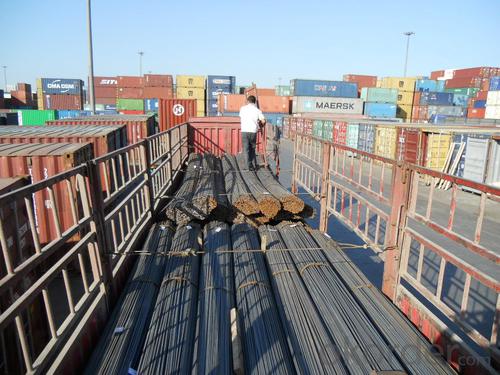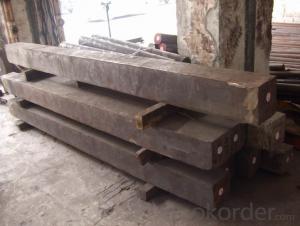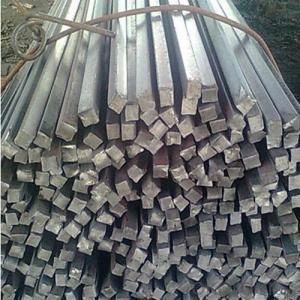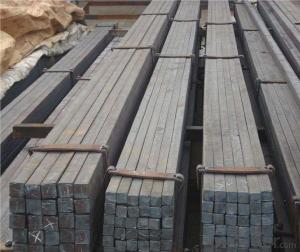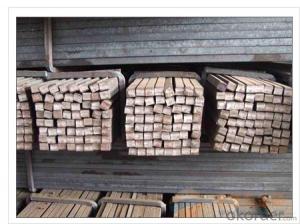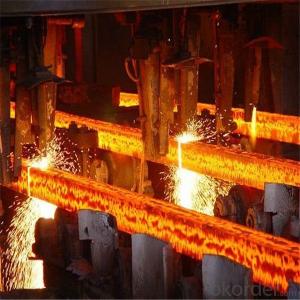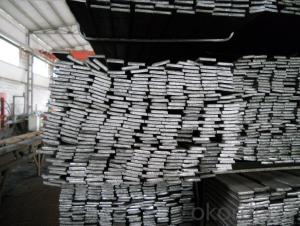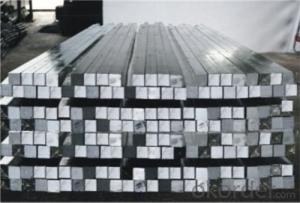square steel; square bar;billet
- Loading Port:
- Tianjin
- Payment Terms:
- TT OR LC
- Min Order Qty:
- 1000 m.t.
- Supply Capability:
- 30000 m.t./month
OKorder Service Pledge
OKorder Financial Service
You Might Also Like
Product Description:
Specifications of Square Steel:
-The Square Steel is hot rolled,
-Standard: GB,
-Grade: Q195 or equivalent.
Some details of Square Steel:
-List 1.The length of a side and the theoretical weight of Square Bar.
Length of a side(mm) | Theoretical weight(kg/m) | Length of a side(mm) | Theoretical weight(kg/m) |
6 | 0.283 | 32 | 8.04 |
7 | 0.385 | *33 | 8.55 |
8 | 0.502 | 34 | 9.07 |
9 | 0.636 | *35 | 9.62 |
10 | 0.785 | 36 | 10.17 |
11 | 0.950 | 38 | 11.24 |
12 | 1.13 | 40 | 12.56 |
13 | 1.33 | 42 | 13.85 |
14 | 1.54 | 45 | 15.90 |
15 | 1.77 | 48 | 18.09 |
16 | 2.01 | 50 | 19.63 |
17 | 2.27 | 53 | 22.05 |
18 | 2.54 | *55 | 23.6 |
19 | 2.82 | 56 | 24.61 |
20 | 3.14 | *58 | 26.4 |
21 | 3.46 | 60 | 28.26 |
22 | 3.80 | 63 | 31.16 |
*23 | 4.15 | *65 | 33.17 |
24 | 4.52 | *68 | 36.3 |
25 | 4.91 | 70 | 38.49 |
26 | 5.30 | 75 | 44.16 |
*27 | 5.72 | 80 | 50.24 |
28 | 6.15 | 85 | 56.72 |
*29 | 6.60 | 90 | 63.59 |
30 | 7.06 | 95 | 70.85 |
*31 | 7.54 | 100 | 78.50 |
Notes:
1, The theoretical weights in the list, base on the density of 7.85 g/cm3.
2, The numbers with *mean that they are not regulars or we don’t offer them.
-List 2. The allowed tolerance of Square Steel:
Length of a side(mm) | Allowed Tolerance | ||
Group1 | Group2 | Group3 | |
5.5~7 | ±0.20 | ±0.30 | ±0.40 |
7~20 | ±0.25 | ±0.35 | ±0.40 |
20~30 | ±0.30 | ±0.40 | ±0.50 |
30~50 | ±0.40 | ±0.50 | ±0.60 |
60~80 | ±0.60 | ±0.70 | ±0.80 |
80~110 | ±0.90 | ±1.0 | ±1.1 |
110~150 | ±1.2 | ±1.3 | ±1.1 |
150~190 | ―― | ―― | ±2.0 |
190~250 | ―― | ―― | ±2.5 |
Chemical Composition:
Standard | Grade | Element (%) | ||||
GB | Q195 | C | Mn | S | P | Si |
≤0.12 | ≤0.50 | ≤0.04 | ≤0.035 | ≤0.3 | ||
-Method of deoxidation: F, b, Z
Usage/Applications of Square Steel:
-The Square Steel is normally used as structure steel.
-Row material for other structure steel like steel angles, channels, I-beams, H-beams, etc…
Packaging & Delivery of Square Steel:
-Packing Detail: The products can be packed in bundles by steel wires.
-Delivery Detail: 30~45 working days after receive buyer’s T.T. or L/C.
Transportation & Marking:
-Transportation:
1, The products can be delivered by bulk vessel or by container.
2, The maximum quantity of loading of container is 25 tons.
3, The products usually are transported to the nearest port from the production place.
-Marks:
1, Color mark: there will be color marking on both ends of the bundles for the cargo delivered by bulk vessel. That makes is easily to distinguish at the destination port.
2, Tag mark: the tag marks will be tied up to each bundle. The information is usually including supplier’s logo and name, product name, made in China, products’ specifications and other information requested by customers.
Payment:
-Invoicing on theoretical weight or actual weight as customer’s request.
-Regular terms of payment:
1, 30% payment in advance, the remaining balance (70% payment) against the copy of B/L.
2, 30% payment in advance, the remaining balance (70% L/C) against the copy of B/L.
3, Negotiable.
- Q: Can a steel square be used for checking the squareness of a power planer table?
- It is not possible to use a steel square to check the squareness of a power planer table. Steel squares are commonly used to check the squareness of corners or edges of materials, but they are not suitable for larger surfaces like power planer tables. In order to accurately check the squareness of a power planer table, it is recommended to use specialized tools such as precision straight edges or dial indicators. These tools provide precise measurements and ensure that the table is perfectly square, which is crucial for achieving accurate and consistent planing results.
- Q: Can a steel square be used for marking straight lines?
- Yes, a steel square can be used for marking straight lines. It is a versatile tool commonly used by carpenters, metalworkers, and other tradespeople to ensure accurate measurements and straight lines when cutting or marking materials.
- Q: What is the weight of a typical steel square?
- The weight of a typical steel square can vary depending on its dimensions, but it is generally calculated by multiplying the density of steel (usually around 7850 kg/m^3) by the volume of the square.
- Q: How do you use a steel square to lay out a octagon?
- Achieving precise and accurate results when using a steel square to lay out an octagon requires a step-by-step approach. Here is a breakdown of the process: 1. Locate the center of the desired area for the octagon and clearly mark this point. 2. Align one side of the steel square with the center point, ensuring that the long edge of the square is parallel to the center line. 3. Slide the square along the center line until the desired measurement for one side of the octagon is attained. For instance, if you want each side to measure 12 inches, adjust the square until the 12-inch mark on the long edge aligns with the center point. 4. Once the square is properly positioned, utilize a pencil or marker to mark the point where the short edge of the square intersects with the outer edge of the area. This mark represents one of the octagon's corners. 5. Rotate the square 45 degrees while maintaining alignment of the long edge with the center line. The short edge will now be oriented in a different direction. 6. Repeat the process of sliding the square along the center line until the desired measurement is achieved, similar to step 3. 7. Mark the point where the short edge intersects with the outer edge of the area. This mark will serve as the second corner of the octagon. 8. Continue repeating steps 5 to 7, rotating the square 45 degrees each time and sliding it along the center line, until all eight corners of the octagon have been marked. 9. Once all eight points are marked, connect them using straight lines to form the octagon shape. By diligently following these steps, you can effectively utilize a steel square to lay out an octagon with utmost precision and accuracy.
- Q: Can a steel square be used for aligning fence posts?
- Indeed, aligning fence posts can be achieved through the utilization of a steel square. This highly versatile tool, known as a framing square, is capable of performing various carpentry tasks, one of which is aligning fence posts. Its design, resembling the shape of an "L," enables precise measurements and accurate right angle alignment, rendering it an ideal choice for guaranteeing correct positioning and uniform spacing of fence posts. By placing the steel square against each post and making adjustments until it attains perfect verticality, one can ensure that every post is properly aligned, thereby resulting in a fence that is both straight and sturdy. Moreover, a steel square can also be employed for assessing plumbness and squareness during the installation of cross braces or other fence components.
- Q: How do you use a steel square to create finger joints?
- Achieving finger joints using a steel square requires a set of essential tools and following a step-by-step process. Here is a breakdown of how you can accomplish it: 1. Gather the necessary tools: You should have a marking knife or pencil, a chisel set, a mallet or hammer, a sturdy workbench or surface, and, most importantly, a steel square. 2. Prepare the wood: Begin by carefully selecting suitable wood for your finger joints. Ensure that it is defect-free and flat. Cut the wood pieces to the desired dimensions for your project. 3. Mark the wood: Utilize the steel square to mark the width and location of the finger joints on both wood pieces. This square will assist in creating accurate and straight lines. Measure and mark the width of the fingers and the gaps between them. 4. Determine the depth: Use a marking knife or pencil to score the marked lines on the wood. This step will serve as a guide for your chisel during the cutting process. Ensure that the depth of the cuts matches the thickness of the adjacent wood piece. 5. Remove the excess wood: Securely place the wood on a workbench or sturdy surface. Employ the chisel and mallet or hammer to cautiously eliminate the excess wood between the scored lines. Start by making shallow cuts along the marked lines and gradually deepen them until the waste wood is removed. 6. Test the fit: Once you have completed the cuts on one wood piece, assess the fit by inserting the fingers into the corresponding gaps of the adjacent wood piece. The joints should fit snugly without any gaps or looseness. If necessary, make the required adjustments using the chisel until you achieve a perfect fit. 7. Glue and assemble: Apply a thin layer of wood glue to the joints and press the pieces together. Use clamps or other appropriate methods to hold the joint in place while the glue dries. Follow the recommended drying time provided by the manufacturer. 8. Finalize the details: Once the glue has dried, utilize sandpaper or a file to smoothen any rough edges or imperfections in the joint. This final step will result in a clean and professional finish. By adhering to these steps and relying on a steel square as your guide, you can create precise and sturdy finger joints for your woodworking projects. Remember to exercise caution and work slowly and carefully to achieve optimal results.
- Q: How do you use a steel square to determine the angle of a dado groove cut?
- To determine the angle of a dado groove cut using a steel square, you can follow these steps: 1. Place the steel square against the edge of the board where you want to cut the dado groove. 2. Align one side of the square with the edge of the board. 3. Take note of the angle marked on the steel square where it intersects with the opposite edge of the board. 4. This angle represents the angle at which you need to set your saw blade or guide to make the dado groove cut.
- Q: Can a steel square be used for checking the squareness of a scroll saw blade?
- Checking the squareness of a scroll saw blade cannot be done with a steel square. Although a steel square is useful for assessing the squareness of various woodworking joints and cuts, it is not suitable for evaluating the squareness of a scroll saw blade. Scroll saw blades are made of thin, delicate, and hardened steel. They possess a unique shape and design that differs from the straight edge of a steel square. The blade of a scroll saw is typically curved, allowing for precise and intricate cuts. To accurately check the squareness of a scroll saw blade, it is recommended to utilize specialized tools like a scroll saw blade square or a scroll saw blade alignment jig. These tools are specifically designed for this purpose and provide the necessary angles and measurements to ensure proper alignment of the blade. Employing a steel square, which is designed for straight edges, may yield inaccurate results and could potentially harm or deform the delicate scroll saw blade. It is always advisable to use the appropriate tools for specific tasks to guarantee precise and safe outcomes.
- Q: How do you use a steel square to measure the width of a picture frame?
- To use a steel square to measure the width of a picture frame, you will need to follow a few simple steps. First, ensure that your steel square is clean and free from any dirt or debris that could affect your measurements. Next, place the steel square against one side of the picture frame, aligning it with the edge of the frame. Make sure that the square is flush against the frame and not tilted or slanted in any way. Once the steel square is properly positioned, use the measuring scale on the square to determine the width of the frame. Read the measurement value where the other side of the frame intersects with the scale on the square. It is important to note that steel squares typically have both metric and imperial measurements, so ensure you are using the appropriate scale for your needs. Repeat this process on the opposite side of the frame to validate your measurement. If the frame is not perfectly square, take multiple measurements at different points and use the average to get a more accurate width. Overall, using a steel square to measure the width of a picture frame is a straightforward process that provides accurate results, making it a reliable tool for this purpose.
- Q: Can a steel square be used for framing?
- Yes, a steel square can be used for framing. A steel square, also known as a framing square or carpenter's square, is a versatile tool commonly used in construction and woodworking. While traditional framing squares are typically made of wood or aluminum, steel squares offer additional durability and sturdiness. They consist of a long arm (body) and a shorter arm (tongue) that meet at a 90-degree angle, forming an L-shape. The body of the square is usually 24 inches long, and the tongue is usually 16 inches long. Steel squares have various markings and measurements along their edges, which make them useful for framing tasks. They can be used to lay out and mark straight lines, accurately measure angles, determine levelness and squareness, and check the alignment of walls, doors, windows, and other components during the framing process. Steel squares are especially beneficial when working with metal framing or when extra strength and durability are required. They are also resistant to warping and bending, ensuring precise measurements and reliable results. In summary, a steel square is a suitable tool for framing purposes due to its strength, durability, and versatility. It is commonly used by carpenters, construction workers, and woodworkers to ensure precise and accurate framing measurements and alignments.
Send your message to us
square steel; square bar;billet
- Loading Port:
- Tianjin
- Payment Terms:
- TT OR LC
- Min Order Qty:
- 1000 m.t.
- Supply Capability:
- 30000 m.t./month
OKorder Service Pledge
OKorder Financial Service
Similar products
Hot products
Hot Searches
Related keywords



